Kratom and kava have both become increasingly popular in the western world. On the surface, they seem to have a lot in common. Both substances come from plants. They’re often sold alongside each other, and are often used to relieve anxiety. This may lead you to the question of whether you should try kratom or kava.
Both kratom and kava carry benefits and risks. We’ll touch on them here, but for a deeper dive on some of these specific properties, check out these articles on kratom for sleep and kratom for energy.
Despite the surface-level similarities, they’re entirely different substances with completely different psychoactive processes. Before consuming either, it’s important to have a baseline understanding of not only their effects, but their mechanisms for effect. As we all (hopefully) learned in high school biology, form follows function, and that holds true here as well.
Here are the factors that make kratom and kava very different from each other, and the steps you should take before consuming either.
Different Plants
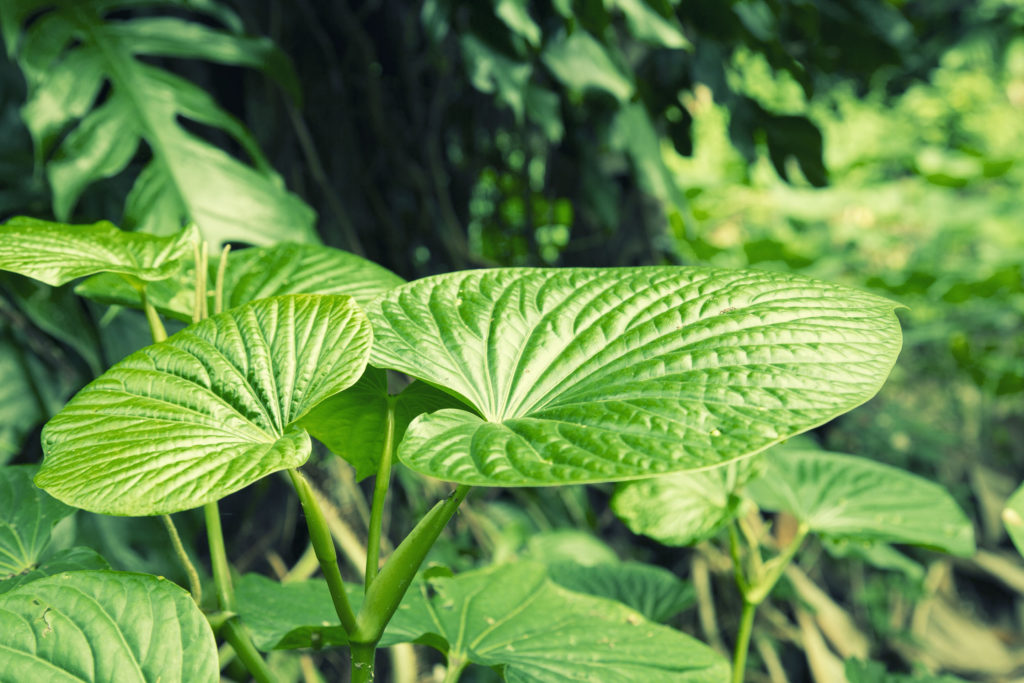
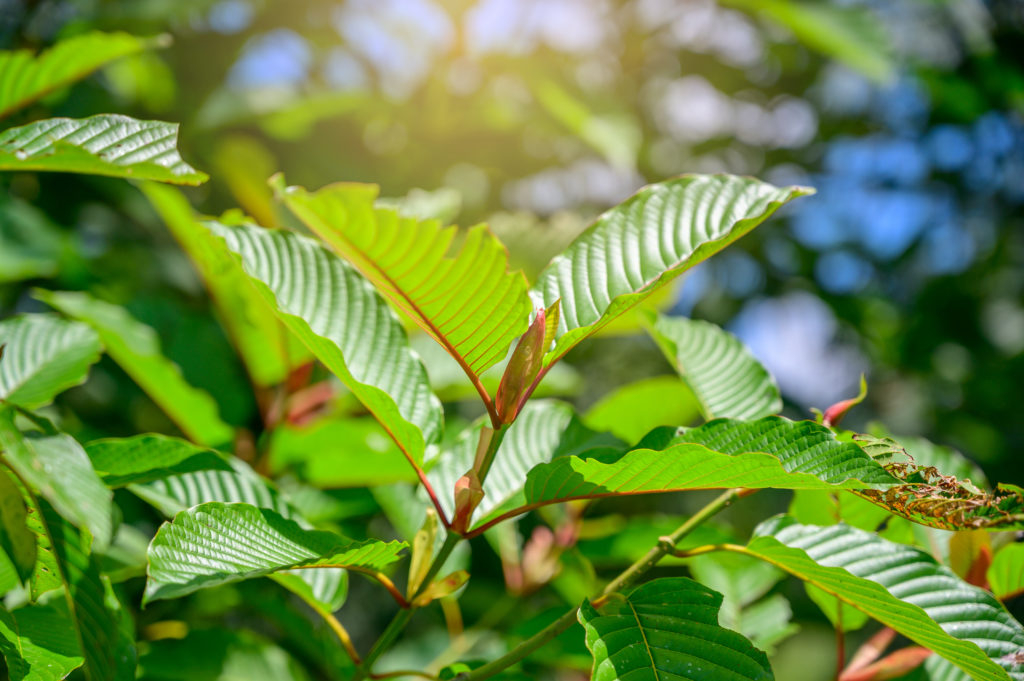
Kratom and Kava are similar in that they’re both naturally-occurring substances extracted from plants with very different evolutionary backgrounds.
Kratom comes from a tree called mitragyna speciosa native to Southeast Asia. The tree is a cousin of coffee plants.
Kava comes from the plant piper methysticum, which is indigenous to the Western Pacific, like Hawaii and other islands. This plant belongs to the pepper family.
Since they’re not even closely-related species, their properties will also be very different. Historically we can look at how they were used among the populations indigenous to where they grow. In Thailand where Kratom grows, they chewed the leaves of the kratom tree to
Similar Effects, Different Mechanisms
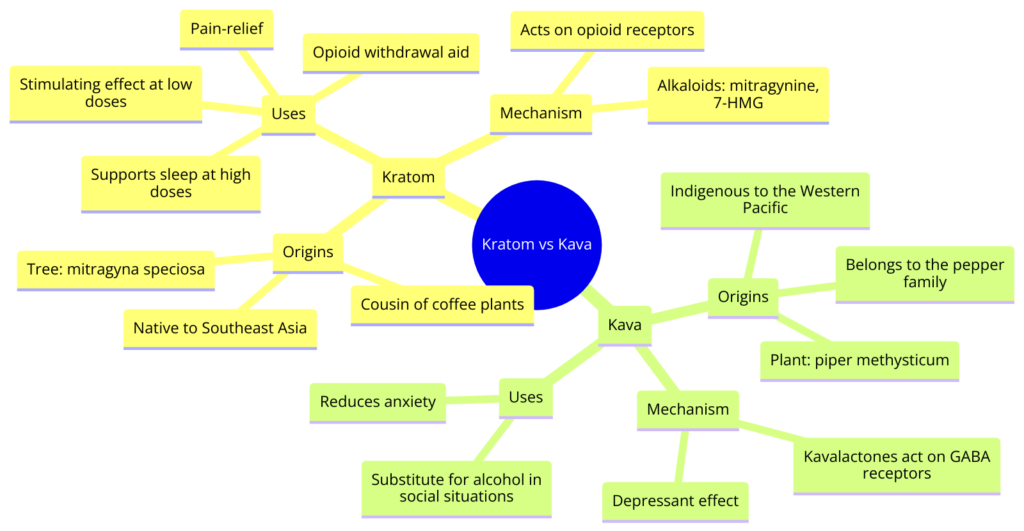
Both plants can relieve stress, anxiety, and even support sleep and insomnia in several instances. However they do so with completely different mechanisms.
Kava’s Mechanism
Kava contains a class of compounds called kavalactones which act on the gamaminoburtyic-acid (GABA) receptors. GABA is notoriously linked to sleep and relaxation, which makes kava a clear depressant. This mechanism also makes perfect sense why kava reduces anxiety. This makes kava’s main use as a substitute for alcohol in social situations. Both compounds are classified as depressants.
Kratom’s Mechanism
Kratom contains two alkaloids, mitragynine and 7-hydroxymitragynine (7-HMG), which act on the same receptors as other psychoactive compounds like opioids. Because these serious painkiller drugs act on these receptors, they’re called the opioid receptors. As you can imagine, this explains a lot of the controversy with kratom. But it also explains one of the more potentially beneficial use cases, and that’s its use in opioid withdrawal.
At modest doses, this reaction in the brain provides a stimulating effect like its cousin, coffee, and pain-relief effects. At higher doses, it can support sleep as well, a controversial claim which we explore in greater depth here.
Green Kratom Strains for a Similar Effect
If you want the mix of alertness and euphoria but with a relaxant effect, which is as close to kava as you’re going to get, then use green strains of kratom. Green strains are a mix of red and white, which have differrent alkaloid compounds. Generally, red is less stimulating than white, so green gives a mix of both.
As we’ll talk about later, you should only get kratom from a trusted source. So if you want to try kratom for this effect, Viable Solution’s Green Maeng Da is a safe place to start.
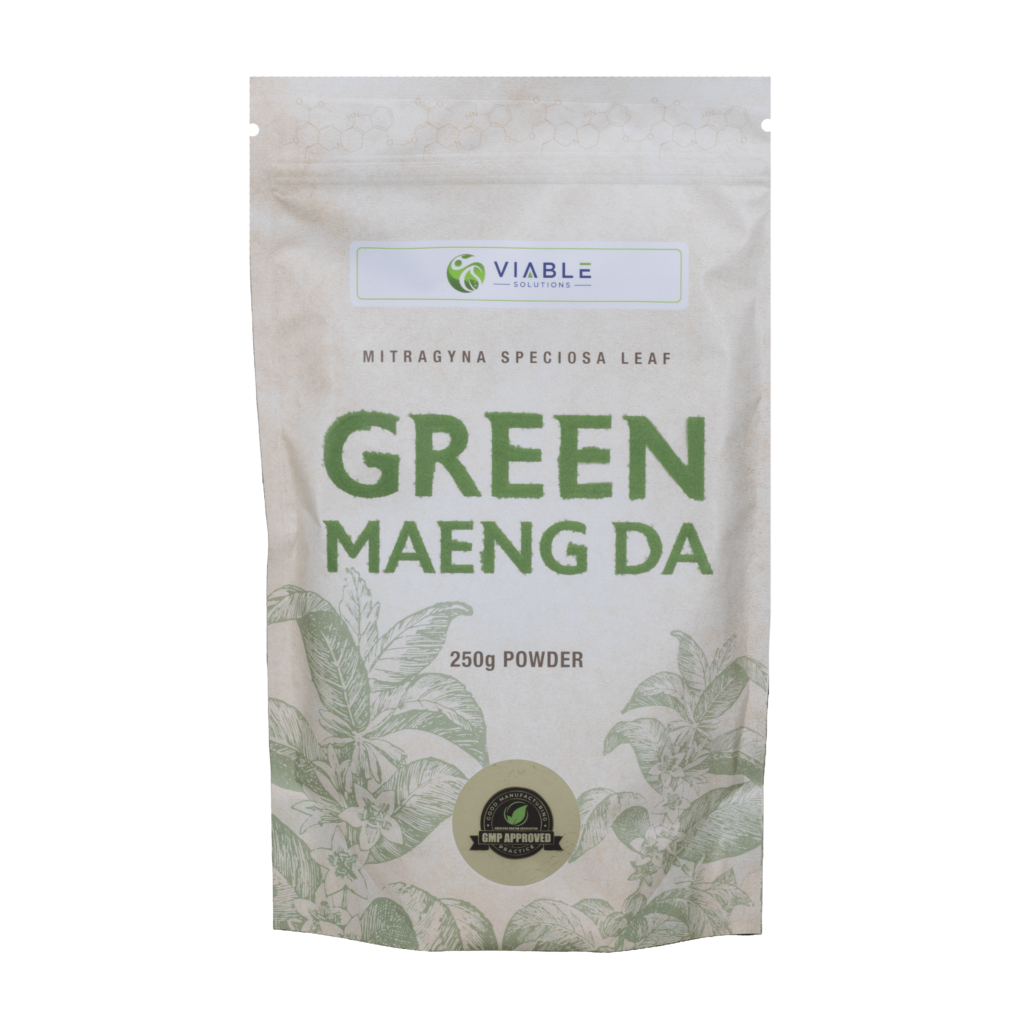
Learn more about Viable’s Green Maeng Da Kratom.
Different Effects
Sure, kava and kratom can have similar effects, but they have many differences as well which stem from the different mechanisms.
First, because kratom acts on the opioid receptors, it has the potential to support opioid withdrawal. It also clearly has a pain relief effect which kava lacks. So if you’re looking for either of those two benefits, kratom is the way to go.
Second, kratom can be a sedative at high doses of certain strains, but in general, it has a stimulant effect. We can go back to its indigenous uses to see this and it’s backed by countless anecdotal evidence from the 5 million plus kratom users in the US alone.
While there are similarities, these are completely different substances with very different effects.
Different Use Cases
Because they’re different, they’re used differently too.
How Kava is Used
Kava traditionally was used before ceremonies as a way to bring people together. Today it’s used as a social drink at bars (kava bars, where they don’t sell alcohol). It’s used to relax and relieve anxiety.
Many report it as a replacement to alcohol, which means it may have some merit to supporting alcoholics, although as of now there isn’t any research behind this.
How Kratom is Used
Kratom isn’t used as much in social situations, and is more for pain relief, as a stimulant, or at higher doses as a sedative. It also, as we’ve mentioned, has potential for opioid withdrawal.
In other words, entirely different uses.
Risks of Kratom vs Kava
Addictive Potential
Like almost any substance, from everything from caffeine to alcohol, both kratom and kava have addictive potential. Anybody who tells you one of them isn’t, is almost definitely trying to sell one of them to you. (I’m talking to the kava sellers in particular, who love to claim that kava isn’t addictive.)
The addictive potential of kratom is stronger and more recognized. If you generally have a problem with moderation and addiction, it might not be the best choice for you to either get that energy boost, help relieve pain, or improve your sleep. But in moderation, like almost anything, can have remarkably beneficial effects and is perfectly safe. Many users anecdotally claim that as long as you don’t go above 5g per day of kratom, you won’t have anything more than minor side effects.
Often kava is claimed as non-addictive. This is simply not true. Like I said, they’re trying to sell you kava. Kavalactones also act on receptors that signal the release of dopamine, leading to a euphoric experience like we feel with other drugs, like alcohol. Anything that releases dopamine part of us will want more and more of. That said, the addictive potential is likely much lower than that of kratom. However, keep this in mind when using kava.
Health Problems
Kratom used frequently at high doses can cause nausea, sweating, and other common withdrawal symptoms. We won’t dive in too much, but if you take kratom ALL THE TIME, that’s inadvisable. If you take alcohol all the time too, that’s inadvisable. There are almost no total panacea substances you can take without care. And the ones that are unequivocally safe, like fish oil, generally won’t have as strong an effect.
Kava’s main reported health effect is liver damage. It’s kind of funny, that like alcohol, kava can damage the liver. Again in moderation it’s probably nothing to worry about, but do not abuse kava.
Regulation
Kratom is legal in the US, but is not FDA approved so it’s not subject to strict, safe manufacturing processes. This means that kratom you buy in stores and online, may be contaminated and complete garbage.
This is crucial when selecting kratom. You should ONLY buy kratom from places with transparent manufacturing and third-party approval. To that, Viable Kratom has the strictest and most transparent processes in the industry, so if you do give kratom a shot, keep it simple for yourself and get it from them. DO NOT buy kratom from your local gas station or smoke shop. You’ll have no way of knowing what you’re getting.
Kava is legal and available at places like “kava bars.” Not only is it legal, but it’s classified as a dietary supplement by the FDA, and therefore is subject to many of its regulations. This is generally positive because it means Kava in the US is less likely to be contaminated or otherwise made with shady practices. Keep in mind, though, that supplements still have limited regulation, and supplement companies can get away with a lot. Like kratom, you should still seek out kava sources that are third-party tested.
Can You Take Kratom and Kava Together?

There is no research on combining the two, but it seems like it’s not necessary. Although there are products on the market right now that combine them, taking a stimulant (kratom) and a depressant (kava) on the surface seems counterproductive. I would try one based on your specific circumstance if you’re trying to reduce anxiety and see for yourself how it helps you.
These are substances with a lot of potential and are both worth exploring, but they carry risks. Like a good scientist, do your best to isolate variables and start by trying them separately if you think they can support you.
Kratom and Kava In Conclusion
While kratom and kava share some surface-level similarities and are often used for similar purposes, they are different substances.
Kratom, derived from the leaves of the mitragyna speciosa tree native to Southeast Asia, contains alkaloids that act on opioid receptors, potentially providing pain relief and aiding in opioid withdrawal.
On the other hand, kava, extracted from the roots of the piper methysticum plant indigenous to the Western Pacific, contains kavalactones that interact with GABA receptors, inducing relaxation and anxiety relief.
Both substances have their own set of risks, including potential health problems and regulatory issues.
Whether to try kratom or kava depends on your preference and desired outcome. Be sure to always start with a small dose, and book a consult with your doctor if you are unsure about your usage.
Kratom and Kava: Frequently Asked Questions
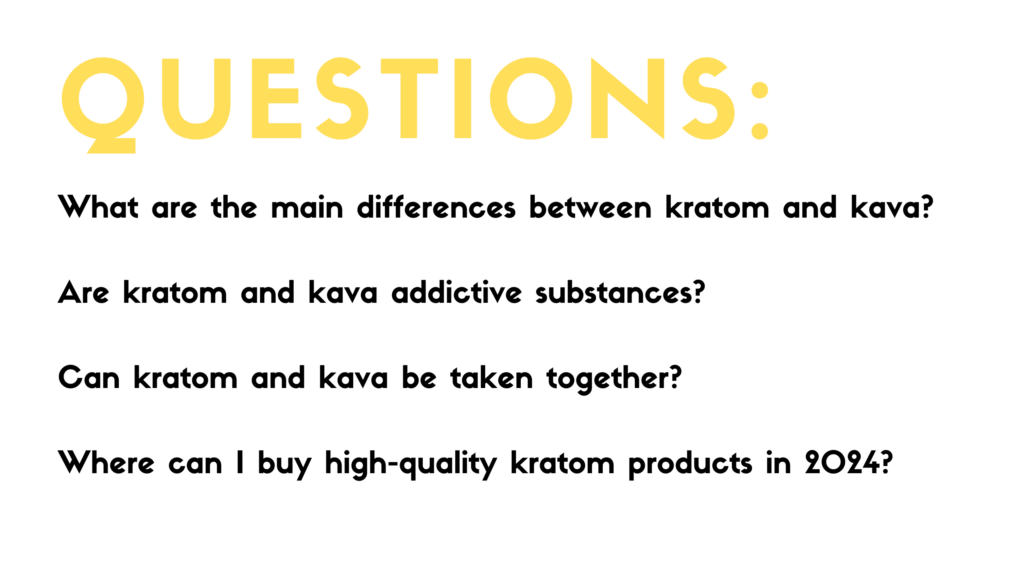
Q: What are the main differences between kratom and kava?
A: Kratom and kava differ in their botanical origins, mechanisms of action, and effects. Kratom is derived from the leaves of the mitragyna speciosa tree and contains alkaloids that act on opioid receptors, providing pain relief and potentially aiding in opioid withdrawal. Kava, on the other hand, comes from the roots of the piper methysticum plant and contains kavalactones that interact with GABA receptors, inducing relaxation and anxiety relief.
Q: Are kratom and kava addictive substances?
A: Both kratom and kava have addictive potential, although the degree varies. However, the addictive potential of kava is generally considered to be lower than that of kratom. It’s essential to use both substances in moderation and source them from reputable suppliers to minimize risks.
Q: Can kratom and kava be taken together?
While there is no research on combining kratom and kava, it’s generally considered unnecessary and potentially counterproductive. Kratom is a stimulant, while kava is a depressant, so combining them may not produce your desired effects and could lead to unpredictable outcomes. 10/10 don’t recommend.
Q: Where can I buy high-quality kratom products in 2024?
A: We recommend shopping with Viable or MOTARK to order your high-quality kratom at the best prices available online.
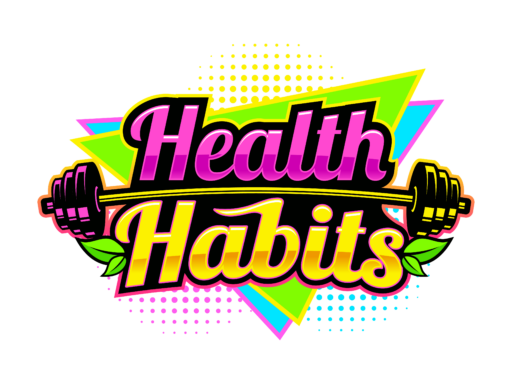

September 9, 2022 at 11:21 pm
Thank you for the info. I use kratom for shoulder pain and it seems to help but finding good quality kratom in my home town is difficult to say the least. I have never tried kava but it seems like something I would be interested in trying since I don’t drink alcohol much anymore.
September 10, 2022 at 4:53 am
“Often kava is claimed as non-addictive. This is simply not true” I’m going to push back on that a bit. “Addiction” doesn’t have one single scientific definition, which is why people joke about being “addicted” to their favorite ice cream. Looked at in a certain way, the claims of ice cream addiction, or candy bar addiction can’t be disproved. There’s a lot of grey area in between that and a serious addiction to methamphetamine, for example. In the 70s and into the 80s, a lot of scientists defined addiction by withdrawal symptoms. This unfortunately resulted in the myth that cocaine wasn’t addictive. On the other extreme, although SSRI antidepressants can have really serious physical withdrawal symptoms, but psychiatrists often deny that it is an addiction. After all, SSRIs like Prozac are not recreational, and they are meant to make the user more functional, not less. My point is just that definitions of addiction have been fluid ever since. Certainly, the Tobacco Industry argued their product was not addictive for decades. That seems patently absurd now, but it demonstrates just how far the definition of “addiction” can be stretched.
Kava does not have withdrawal symptoms. That fits the older definition. It’s also not known to ever inspire people to crime in order to support a habit. There’s no pattern of habit reinforcement like for cigarettes or coffee. Probably not even compared to ordinary sugar. And I’m pretty sure any clinical cases of kava “addiction” involve mental illness, and/or used in combination with other recreational substances. Are such cases enough to say it can be addictive? I would argue not, but I recognize that’s enough to fit other people’s definition.
And, kava got hit hard by being banned in many countries in part because supplement manufacturers were using the entire plant, and the leaves and stems have more damaging effects on liver. Traditional usage throughout the South Pacific was strictly to use kava roots. It is a story of supplement makers being greedy and making it tough for everyone. Australia had strict laws against kava, I think they’ve been loosened recently, as the policy has been seen as racist, a slight against Maori culture and traditions. Kratom doesn’t have nearly as much traditional use, at least not outside of Thailand. That’s another consideration
September 13, 2022 at 3:16 pm
These are certainly good points, and bring up worthwhile discussions about the nuances in the definitions of the language we use. However, the point that we were speaking to, which is that lots of kava sellers claim there is no addictive potential in any form however you define it, is a misleading claim.
Nonetheless, fantastic points.